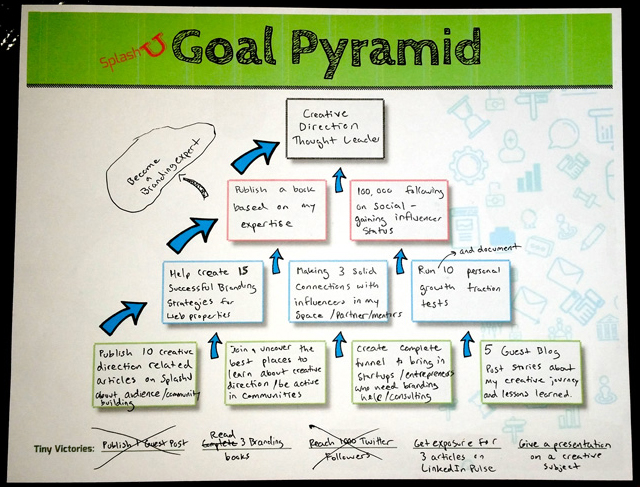Every good marketer must know how to define a branding goal and strategy.
But, order matters. Before you can build a strategy, you must define a goal first.
Define a Branding Goal and Strategy
Define Your Goals
When it comes to defining an overall marketing plan, it can be easy to get caught up in the logistics of execution. That’s why we start with the very end in mind. Before worrying about how to capture your full personality in a 140-word micro statement for Twitter, you have to define your goals with building a digital brand.
Do you want to be an industry expert? Are you looking to land more public speaking gigs? Or is your ultimate career goal to get hired as the CEO of a multibillion-dollar corporation one day?
Choose a specific goal, and unpack it into milestones. You can use the goal pyramid below as template for tracking and defining your own goals. Doing this exercise will help you visualize the steps you need to take to achieve your digital branding goals.
Here is an example of my personal goal sheet that I recently filled out:

You can see that I started with the ultimate goal of becoming a creative direction thought leader. Now, the blog posts that I publish, the guest posts that I take on, the content that I share, and practically everything that I do on my personal social media aligns with my goal.
It can be tough to stay on track, but that’s why it’s nice to have a visual representation to remind you of where you are headed. I recommend filling out a goal sheet and hanging it up next to your computer to act as inspiration.
Define Your Strategy
Now that you’ve got your goals in place, it’s time to shift focus to strategy.
What are your best qualities? What are you most passionate about? How do others perceive you?
What do you believe that others don’t? What do your employees, your team, or your friends look to you for on a regular basis?
How can people get behind you and the issues you stand for?
Start crafting a strategy to get where you want to be by using these attributes to your advantage.
Ultimately, your strategy should reflect your predefined goals, and everything you do on social media (or even in person), should be in alignment.
Before you post or share anything, think to yourself “would I actually say this?” “should I actually say this?” “am I going to regret sharing this with my audience?” “how does this make me look?” “does this post get me closer to my digital branding goals?”
Your industry can also dictate a lot about how liberal you can be with your language and what types of content you should share. For instance, if you are a fired up chef like Gordon Ramsay from Hell’s Kitchen, it may work really well for you to berate your audience for the entertainment value.

But, if you are looking to build authority in a more serious space like, biotechnology, it would be less acceptable for you to lash out in curse words or post inappropriate pictures of yourself partying on the weekend.
Don’t think of this as lying, or being someone you are not. According to Michael Port, we all are actors and play various roles at various times. Your digital brand is a reflection of many of your traits, but it might hold back on a few as well, especially the nefarious and (ironically) personal stuff.
Gary Vaynerchuk, who is often considered one of the most authentic brands out there, doesn’t talk about his family at all online. That doesn’t mean he doesn’t talk about his family… He has elected to have his digital brand leave out his family. And that’s okay because it suits him and his industry.

Curate
You can also think about your digital brand as an opportunity to show your personality by curating the things you like into one feed.
People follow you because they are interested in the kind of content you are sharing. They trust you to be able to curate for them. Social Media ninja Guy Kawasaki tweets every 2 minutes from his account to over 1.5 million followers. People go to Guy’s feed because they know his brand is funny, yet informative. It’s consistent, yet heavily curated.
When people trust you to curate for them, this is when you start building authority. So when you are writing out your strategy, remember to consider what content topics you want to be known for, what other influencers in your industry are doing, and how you want to be perceived by your audience.
This will help you stay in line with your goals.
Use what works
Rommel Cabbal from the Startup Lifehacks Podcast built his brand by following the exact strategy of the legendary brand John Lee Dumas, but he put his own twist on it. Rommel launched his podcast using the exact same formula as JLD and was able to build a strong brand with it.
While there was a clear resemblance in strategy, his articulation and delivery were clearly different, as well as his target market. This is a great example of how you can uniquely model your strategy after what’s working for another industry influencer without just being a copycat.
Do you agree? Let me know. Respond in the comment section below…











